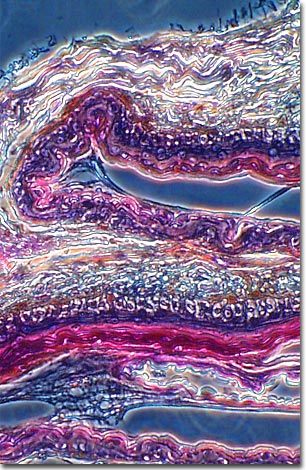Phase Contrast Image Gallery
Snake Skin
A stained thin section of snake skin imaged using phase contrast optics is illustrated below. The image was captured using an Olympus IX-70 inverted microscope equipped with a DP-10 digital camera.

Contrary to popular belief snake skin is dry, not slimy (with the exception of newly born or hatched snakes). Snake skin consists entirely of overlapping scales, specialized folds of skin, that provide protection from the environment and from predators. The scales are composed primarily of keratin, but also contain waxes that help to prevent water loss through the skin.
Epidermis is not replaced on an ongoing basis in snakes as it is with other animals. When the snake grows too large for its skin, or the skin begins to wear out, it is shed in one piece. This molting process can happen several times a year, if a snake is young and growing, or it may just occur once a year to replace worn out skin.
The pattern, type and configurations of scales of shed snake skins are as unique and distinctive as finger prints are amongst humans. People with sufficient expertise can usually identify the species of snake, or the group it belongs to, simply by examining a molted skin.
BACK TO THE PHASE CONTRAST GALLERY
